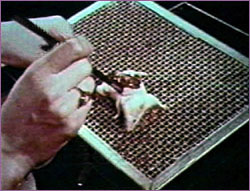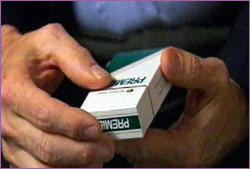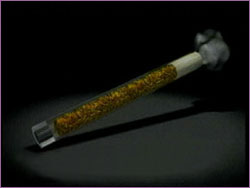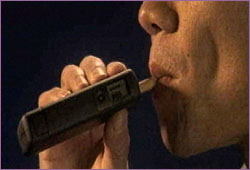|

|

|
|
"Safer" Cigarettes: A History
Part 2 |
Back to Part 1
|
 The mouse that roared
The mouse that roared
|
The XA Project
In the 1970s, Liggett Group, Inc. embarked on its own
safe-cigarette program known as the "XA Project." The
project focused on blending additives to tobacco to
neutralize cancer-causing compounds. The company discovered
that blending certain catalysts with tobacco would destroy
PAH's—the dangerous compounds which form behind the
cigarette's burning tip. The problem was, the company had
demonstrated this in mouse skin painting tests—the
same type of test conducted by Ernest Wynder that the entire
tobacco industry had spent years debunking. Nonetheless,
skin painting tests related to the XA Project showed that
cancerous tumors were virtually eliminated when the catalyst
was added to tobacco.
Liggett faced a marketing problem if it pursued the XA
Project cigarettes. How could the company market the
benefits of the XA Project cigarettes without making health
claims that would subject it to government scrutiny? And how
could the company promote mouse skin tests as proof their
new cigarettes worked at the same time its lawyers were in
courtrooms challenging the validity of mouse tests while
defending the company against smokers' lawsuits? A former
industry lawyer now says that Liggett was pressured by other
cigarette makers to abandon the effort because the
"marketing and sale of a safe cigarette could result in
infinite liability in civil litigation as it would
constitute a direct or implied admission that all other
cigarettes were unsafe." Liggett eventually abandoned the
project.
By the early 1980s, other cigarette makers also had
abandoned many of their efforts to develop a safe cigarette.
In addition to the technological hurdles they faced,
industry lawyers had grown increasingly wary about the
research, and the concession, implicit in such research,
that existing cigarettes weren't safe. Nonetheless, more
than 150 patents related to designing safe cigarettes have
been filed in the United States and the United Kingdom
during the past 25 years. Tobacco executives say the fact
that a patent has been filed doesn't mean the product is
necessarily marketable or acceptable to consumers, but the
sheer volume of patents shows that the industry has invested
heavily in developing a safer cigarette even as its own
executives were denying any link between smoking and
disease. And there are now several claims from former
industry workers that many tobacco companies shelved
research into safer products out of fear of exposing
themselves to additional liability. In 1998, for instance, a
former Philip Morris researcher testified that the company
shelved promising research to remove cadmium, a lung
irritant, from tobacco plants.
 Smokers didn't give Premier a chance, its maker
maintains.
Smokers didn't give Premier a chance, its maker
maintains.
|
|
High-tech cigarettes
Despite such criticism, the major cigarette makers have
attempted to market several versions of safer cigarettes. In
1988, RJR introduced a high-tech cigarette called Premier.
Premier, touted as a virtually smokeless cigarette that
dramatically reduced the cancer-causing compounds inhaled by
smokers, was made of aluminum capsules that contained
tobacco pellets. The pellets were heated instead of burned,
thereby producing less smoke and ash than traditional
cigarettes. Although the product looked like a traditional
cigarette, it required its own instruction booklet showing
consumers how to light it.
From the beginning, Premier had several strikes against it.
RJR had spent an estimated $800 million developing the
brand, and the total cost was expected to soar to $1 billion
by the time it was placed in national distribution. The
costly project was put into test market just as Kohlberg
Kravis Roberts & Co. had embarked on a $25 billion
leveraged buyout of RJR that had saddled the company with
debt. And the cigarette faced a lengthy regulatory battle
after public health officials argued it should be regulated
by the FDA as a drug. But the biggest problem with Premier
was the fact that consumers simply couldn't get used to it.
Many smokers complained about the taste, which some smokers
said left a charcoal taste in their mouths. RJR had also
gambled that smokers would be willing to give Premier
several tries before making a final decision about whether
to smoke it. RLR estimated that to acquire a taste for
Premier, smokers would have to consume two to three packs to
be won over. But as it turned out, most smokers took one
cigarette and shared the rest of the pack with friends, and
few bothered to buy it again. RJR scrapped the brand in
early 1989, less than a year after it was introduced.
In 1989, Philip Morris entered the fray with a virtually
nicotine-free cigarette called Next that it claimed was
better than other low-nicotine varieties because its taste
was indistinguishable from regular cigarettes. The nicotine
was removed from Next using high-pressure carbon dioxide in
a process similar to the method used by coffee companies
when making decaffeinated coffee. Next cigarettes were
touted for their "rich flavor" and referred to as "de-nic"
cigarettes. But tobacco critics complained that Next
actually had higher tar levels than many cigarettes, and
that heavy smokers would simply smoke more Next cigarettes
to give their bodies the nicotine they crave. (To learn how
the brain becomes dependent on nicotine, see
The Dope on Nicotine.) The product flopped and was withdrawn.
|
 In RJR's Eclipse, most of the tobacco doesn't burn
but rather heats up, producing a smoke-like vapor.
In RJR's Eclipse, most of the tobacco doesn't burn
but rather heats up, producing a smoke-like vapor.
|
Despite those setbacks, both RJR and Philip Morris have
tried again with high-tech versions of smokeless cigarettes.
In 1994, RJR began testing the Eclipse smokeless cigarette,
which claimed to reduce secondhand smoke by 85 to 90
percent. Eclipse is more like an ordinary cigarette than its
predecessor Premier because it contains tobacco and
reconstituted tobacco. But it also includes a charcoal tip
that, when lighted, heats glycerin added to the cigarette
but does not burn the tobacco. The result is a cigarette
that emits tobacco flavor without creating ash and smoke.
But RJR isn't touting Eclipse as a safe cigarette, instead
marketing it as a more socially acceptable product less
offensive to non-smokers. Indeed, because Eclipse still
burns some tobacco, it has tar levels similar to those of
ultra-light cigarettes already on the market. Eclipse emits
lower tar levels of cancer-causing compounds than many
existing cigarettes, but it still produces carbon monoxide
and nicotine. And questions have also been raised about the
effects of heating glycerin. When burned, glycerin is known
to be carcinogenic. It also remains unclear whether the FDA
will attempt to regulate Eclipse if RJR launches it
nationally.
Philip Morris is testing its own high-tech cigarette called
Accord, which has been described as a cigarette encased in a
kazoo-shaped lighter. Consumers buy a $40 kit that includes
a battery charger, a puff-activated lighter that holds the
cigarette, and a carton of special cigarettes. To smoke the
cigarettes, a smoker sucks on the kazoolike box. A microchip
senses the puff and sends a burst of heat to the cigarette.
The process gives the smoker one drag and does not create
ashes or smoke. An illuminated display shows the number of
puffs remaining, and the batteries must be recharged after
every pack. It's unclear whether smokers will find the
low-smoke and -ash benefits desirable enough to justify
learning an entirely new smoking ritual. Although Philip
Morris doesn't make health claims about Accord, the company
in 1998 told the Society of Toxicology that Accord generated
83 percent fewer toxins than a regular cigarette.
 For $40, the Accord smoker gets a battery charger,
heating device, and carton of special cigarettes.
For $40, the Accord smoker gets a battery charger,
heating device, and carton of special cigarettes.
|
|
Lowering nitrosamines
Perhaps the most promising new technology to make a safer
cigarette lies in research to lower nitrosamines, those
prevalent and deadly cancer-causing compounds in cigarettes.
Brown & Williamson and RJR are developing cigarettes
that use a special tobacco with lower nitrosamine content.
The tobacco is cured with a special process that inhibits
the formation of nitrosamines. But Brown &Williamson
isn't planning to tout the health benefits of the
nitrosamine-free smoke. "We can't be sure nitrosamine-free
tobacco is necessarily safer," a B&W spokeswoman told
the Wall Street Journal. "We don't want to claim the
product is safer unless we are sure it is. It's a bit of a
muggy area."
Although public health officials describe the quest for a
nitrosamine-free cigarette as a step in the right direction,
the research still raises concerns that smokers could be
lulled into a false sense of security. Cigarettes without
nitrosamines still produce other carcinogens, scientists
say, and more smokers die of heart-related ailments than
cancer. As Dietrich Hoffmann of the American Health
Foundation says, "The best cigarette is no cigarette."
Tara Parker-Pope, a reporter for the
Wall Street Journal, is the author of
Cigarettes: Anatomy of an Industry from Seed to
Smoke
(The New Press, 2001), from which this article was
excerpted with permission.

|

|
Anatomy of a Cigarette
|
"Safer" Cigarettes: A History
|
The Dope on Nicotine
|
On Fire
Resources
|
Teacher's Guide
|
Transcript
|
Site Map
|
Search for a Safe Cigarette Home
Search |
Site Map
|
Previously Featured
|
Schedule
|
Feedback |
Teachers |
Shop
Join Us/E-Mail
| About NOVA |
Editor's Picks
|
Watch NOVAs online
|
To print
PBS Online |
NOVA Online |
WGBH
©
| Updated October 2001
|
|
|
|